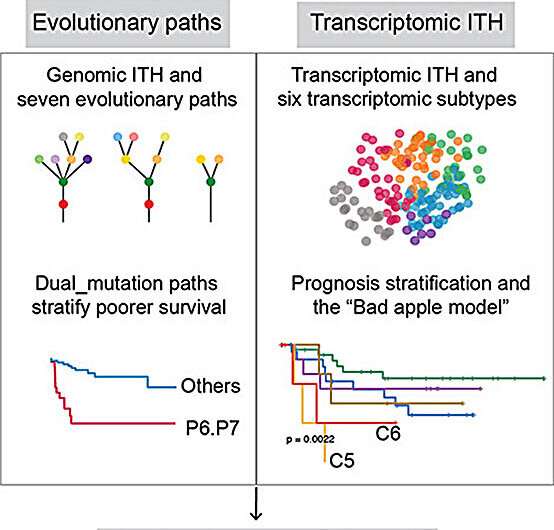This article has been reviewed according to Science X's editorial process and policies. Editors have highlighted the following attributes while ensuring the content's credibility:
fact-checked
trusted source
proofread
Study uncovers multiple molecular subgroups in liver cancer with most aggressive driving clinical outcomes

A study led by clinician-scientists and scientists from the National Cancer Centre Singapore (NCCS) and A*STAR's Genome Institute of Singapore (GIS) has discovered unexpected molecular heterogeneity even within the same liver tumors.
More than 40% of hepatocellular carcinoma (HCC) cases harbor more than one molecular subtype within the same tumor, and in these, the clinical outcomes for the patients are best predicted by the most aggressive subtype. This phenomenon, termed the "bad apple effect," has significant implications on the understanding of liver cancer and suggests that a more holistic sampling of liver cancer tumors is needed to improve the way the disease is studied and treated to optimize patient outcomes.
These new findings are published in the Journal of Hepatology.
In Singapore, liver cancer is the third-most common cause of cancer deaths in males and fifth-most common cause in females. HCC, the most common type of primary liver cancer, is the only common solid organ cancer without any validated predictive biomarkers. This means that doctors are unable to use molecular biomarkers to determine which drug is best for an individual patient with HCC. This is one of the reasons why treatment is less effective compared to other common cancers. The case-fatality ratio of HCC today is 0.92—the highest among all cancers in Asians.
To address this unmet clinical need and improve the treatment of HCC, the PLANet study (Precision Medicine in Liver Cancer across an Asia-Pacific Network), analyzed over 600 tumor and adjacent normal samples that were surgically resected from 123 HCC patients from Singapore, Malaysia, Thailand and the Philippines. Samples were analyzed using a multi-regional sampling approach enabling deep profiling of genomic and cellular heterogeneity within each tumor to evaluate its impact on disease progression.
The team found that there was unexpected intratumoral heterogeneity in the HCC transcriptome, also known as the RNA transcript, which determines the behavior of tumor cells. This indicates that the current practice of obtaining a single sample from liver cancer tumors under-represents the complexity of the tumor significantly and limits a comprehensive understanding of the entire tumor ecosystem. This heterogeneity may explain why developing therapeutics for HCC is a challenge as it cannot be treated by a one-size-fits all approach.
The second key finding was that more than 40% of HCC samples analyzed harbored more than one transcriptomic subtype. Of these, the subtype with the worse prognosis determined each individual patient's clinical trajectory and outcome. This is the first time this "bad apple effect" has ever been shown in HCC. The team also found that early and late tumor evolution characteristics were important in predicting patients' survival.
"Uncovering the 'bad apple effect' in liver cancer progression has generated an important blueprint for HCC that can be used to improve the treatment of the disease. Our study shows a comprehensive landscape of evolutionary history of the disease and is a rich resource for understanding tumor heterogeneity and clinical progression," said Professor Pierce Chow, Corresponding Principal Investigator of PLANet 2.0, senior author of the study and Senior Consultant Surgeon, Division of Surgery and Surgical Oncology, Singapore General Hospital and NCCS.
"The application of genomic technologies has enabled us to produce a high-resolution map of the different cell types that coexist within the same tumor. Now, clinicians are able to pinpoint the specific cell populations which have a more deterministic role in driving the disease and develop therapeutic approaches to target the more aggressive cells in future," said Associate Professor Tam Wai Leong, Theme PI of PLANet 2.0, co-senior author of the study and Deputy Executive Director at A*STAR's GIS.
The group includes collaborators from A*STAR's Institute of Molecular and Cell Biology and Duke-NUS Medical School. The team has continued their studies by using a spatial transcriptomics and spatial metabolomics approach in two therapeutic studies to understand the HCC microenvironment. This approach has found that co-localization of biomarkers is important to the biology of HCC and will be key to making progress in the development and discovery of novel and more effective treatments for HCC.
More information: Jianbin Chen et al, A multimodal atlas of hepatocellular carcinoma reveals convergent evolutionary paths and 'bad apple' effect on clinical trajectory, Journal of Hepatology (2024). DOI: 10.1016/j.jhep.2024.05.017

















